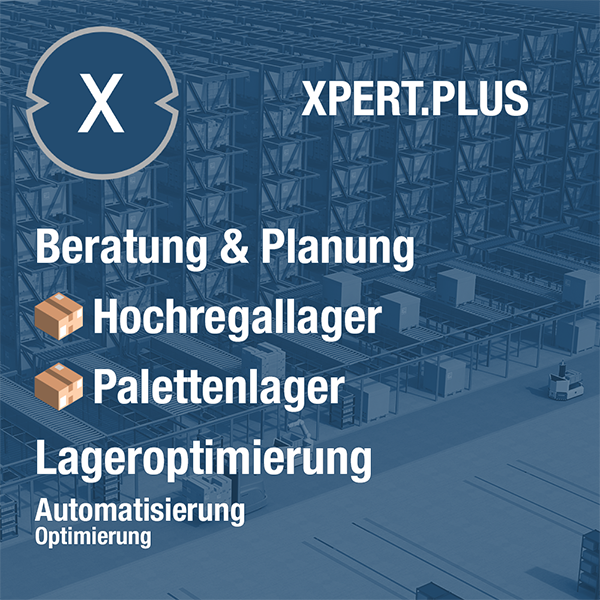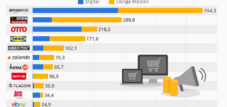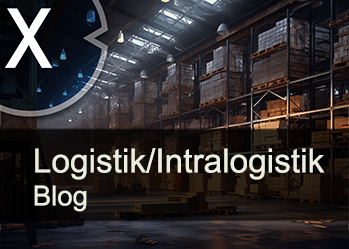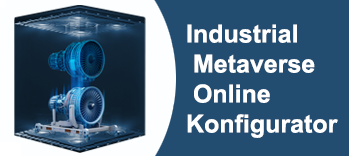From 175 to 3,870 packages per person: How robots unleash a productivity explosion at Amazon
Xpert pre-release
Language selection 📢
Published on: August 23, 2025 / Updated on: August 23, 2025 – Author: Konrad Wolfenstein

From 175 to 3,870 packages per person: How robots are unleashing a productivity explosion at Amazon – Creative image: Xpert.Digital
Amazon and the robot revolution: One million machines are changing the world of work
### Amazon's robot army is growing: 1 million machines – what this means for employees ### AI as the new boss: Why robots are now calling the shots at Amazon and Shopify ### Jobs in danger? Amazon's robot revolution is rolling toward Germany – what you need to know ### More than just warehouse work: How Amazon's super AI "DeepFleet" is directing a million robots ###
Robots are coming, jobs are staying put? How Amazon is preparing its 700,000 employees for the AI future
The news was a bombshell in the world of work and technology: Amazon has surpassed the one million mark for active robots in its fulfillment centers. This impressive number is getting dangerously close to the human workforce of around 1.5 million and marks an irreversible turning point in automation. Controlled by a sophisticated generative AI called "DeepFleet," which acts as an intelligent traffic management system for the entire robot fleet, these machines no longer work alongside humans, but increasingly closely with them – or even replace them.
But this technological milestone raises a pressing question that extends far beyond Amazon's warehouses: Is this the beginning of the end for millions of jobs or the beginning of a new era of collaboration between humans and machines? On the one hand, there are unprecedented efficiency gains, the relief of employees from physically demanding tasks, and the creation of new, highly skilled jobs in maintenance and programming. On the other hand, there is the demonstrable reduction in jobs per location and the growing concern that entire occupational groups will be overwhelmed by the wave of automation.
However, focusing on Amazon alone is too narrow. The e-commerce giant's approach is a blueprint for a development that is sweeping across the entire economy. Companies like Shopify are already making AI skills a basic requirement for their employees, proving that the transformation is not limited to logistics. For the German economy, especially the logistics sector, which is pushing for digitalization, Amazon's development is a clear signal: The AI revolution is no longer a distant vision of the future, but is happening here and now. This change requires employees, companies, and society to urgently address the future of work.
What does Amazon's one million robot milestone mean?
Amazon has reached a remarkable milestone: Over one million robots now work in the e-commerce giant's more than 300 fulfillment centers worldwide. This number is already approaching the number of human employees, which currently stands at approximately 1.56 million. The millionth robot recently went into operation at a fulfillment center in Japan, marking a turning point in supply chain automation.
Since the first robot deployment in 2012, when Amazon acquired Kiva Systems, the robotics landscape has changed dramatically. What began as simple shelf-loaders has now evolved into a complex ecosystem of various robot types. These machines perform tasks ranging from moving heavy loads to autonomously transporting customer orders through warehouses.
How does the DeepFleet AI system work?
At the heart of this new era is DeepFleet, a generative AI model that Amazon describes as "a smart traffic light for millions of warehouse lanes." This Foundation model, trained with extensive internal data on goods movement, coordinates the movements of the entire robot fleet in real time.
DeepFleet works similarly to a language model, generating the next sentence based on previous words. Only instead of words, it generates movement patterns that match the current situation in the warehouse. The system continuously calculates optimized routes for the robots, preventing congestion in the warehouse areas and reducing travel times by about ten percent. Scott Dresser, Vice President of Amazon Robotics, compares it to an intelligent traffic management system that continuously determines more efficient routes instead of rigid specifications.
What different types of robots work in Amazon warehouses?
The variety of robots in Amazon's warehouses is impressive. The Hercules robot can move shelves weighing up to 570 kilograms and navigates using QR codes on the floor. The Pegasus robot replaces traditional conveyor belts and transports individual packages directly to the appropriate shipping points.
Particularly noteworthy is Proteus, Amazon's first fully autonomous robot capable of moving safely among human employees. Unlike other mobile robots, it is not confined to separate workspaces but can operate in open areas of fulfillment centers.
The Sparrow, Cardinal, and Robin robotic arms perform precise gripping and sorting tasks. Sparrow can handle over 200 million different products using AI and computer vision. Cardinal lifts packages weighing up to 23 kilograms and precisely places them in transport carts. Finally, the Sequoia system is a multi-level warehouse system capable of accommodating over 30 million items at its newest facility in Shreveport, Louisiana.
How is the work of Amazon employees changing?
Automation brings both opportunities and challenges for the workforce. Amazon emphasizes that the robots primarily take on heavy and repetitive tasks. At its new high-tech logistics center in Shreveport, the need for employees in reliability, maintenance, and engineering increased by 30 percent.
According to the company, over 700,000 employees have already been retrained for new roles. These training programs range from technical areas such as robotics maintenance to completely unrelated training. Amazon invests up to €4,500 per employee in continuing education programs, ranging from IT support to truck driver training.
The new jobs require different skills. Instead of lifting heavy packages, employees now monitor complex robotic systems, perform maintenance work, or program AI-supported processes. The workstations are more ergonomically designed, as robots bring goods directly to employees instead of requiring them to walk through the warehouse.
What are the effects on employment overall?
Despite the emphasis on new jobs, the reality of job cuts is still there. The average number of employees per Amazon location fell from just under 1,000 in 2020 to approximately 670 in 2024. According to the Wall Street Journal, this is the lowest employment rate in 16 years.
CEO Andy Jassy made it clear in an internal memo that the massive deployment of AI will inevitably lead to job cuts, particularly in traditional administrative, customer service, and developer roles. Amazon is currently developing over 1,000 internal AI applications designed to automate various office tasks.
Productivity per worker has increased dramatically: While in 2015, approximately 175 packages were shipped per worker annually, today the number is around 3,870. About 75 percent of all global Amazon deliveries are now assisted by robots in some form.
Our recommendation: 🌍 Limitless reach 🔗 Networked 🌐 Multilingual 💪 Strong sales: 💡 Authentic with strategy 🚀 Innovation meets 🧠 Intuition

From the bars to global: SMEs conquer the world market with a clever strategy – Image: Xpert.digital
At a time when a company's digital presence determines its success, the challenge is how to make this presence authentic, individual and far-reaching. Xpert.Digital offers an innovative solution that positions itself as an intersection between an industry hub, a blog and a brand ambassador. It combines the advantages of communication and sales channels in a single platform and enables publication in 18 different languages. The cooperation with partner portals and the possibility of publishing articles on Google News and a press distribution list with around 8,000 journalists and readers maximize the reach and visibility of the content. This represents an essential factor in external sales & marketing (SMarketing).
More about it here:
Robots, Artificial Intelligence and the Future of Work
Which industries and professional groups are particularly at risk?
A recent Pew study identifies factory workers as particularly vulnerable to the advance of AI and robotics. Other studies confirm this trend: The Ifo Institute found that 27.1 percent of German companies expect AI-related job cuts in the next five years. Manufacturing is particularly affected, with 37.3 percent of companies anticipating negative employment effects.
In addition to logistics, jobs in accounting, customer service, and data processing are particularly at risk. Routine tasks that can be described by clear rules can increasingly be taken over by AI systems. Mathematicians, accountants, and administrative staff are under particular pressure.
How are other companies responding to the AI revolution?
Amazon isn't alone in this development. Shopify CEO Tobi Lütke introduced an even more radical policy: Before teams are allowed to hire new employees, they must prove that AI can't take over the tasks. "Reflexive AI use is now a basic assumption at Shopify," Lütke explained in an internal memo.
The Canadian e-commerce provider made AI skills a prerequisite for all employees. Lütke's clear message is that those who don't use AI today will no longer be needed tomorrow. The company has already laid off 20 percent of its workforce and sold off business units to focus more on AI-supported processes.
Other tech giants are also following this trend. Microsoft, Google, and many other companies have massively cut jobs in recent years. According to Layoffs.fyi, 551 companies worldwide have already eliminated around 153,000 jobs by 2024, many of them as part of the AI rollout.
What does this development mean for the German economy?
The German logistics industry is taking a pioneering role in the introduction of AI. 22 percent of logistics companies are already using artificial intelligence, and another 26 percent are planning or discussing its use. The industry sees itself as a digitalization pioneer and is investing heavily in automation technologies.
German companies expect similar disruptions to those in the US. The Fraunhofer Institute has identified numerous application areas for AI in logistics, from route planning and demand forecasting to automated load planning. Transport robots that use optical patterns for navigation and AI-supported voice control are already being tested.
What new jobs will be created through automation?
Despite job cuts in traditional fields, new career fields are also emerging. Amazon has already posted 500 robotics job openings on LinkedIn. They are seeking robotics technicians, AI specialists, data analysts, and system integrators.
The new jobs often require higher qualifications, but also offer better pay and more interesting tasks. Instead of monotonous assembly line work, employees monitor complex systems, analyze data, or develop improvements for automated processes.
Amazon is training over 700,000 employees worldwide for these new roles. The company is investing billions in training programs ranging from robotics maintenance to completely unrelated industry training. The goal is to open up career prospects for its employees beyond Amazon.
What does the future of warehouse logistics look like?
Developments are clearly moving toward complete automation. Amazon is already testing humanoid robots and working on voice control for robot systems. In just a few years, robots could take over the majority of physical work in warehouses.
The new fulfillment center in Shreveport offers a taste of this future. With ten times as many robots as conventional facilities, it demonstrates how logistics will fundamentally change. Employees will no longer work against the machines, but with them.
DeepFleet and similar AI systems will further increase efficiency. Continuous optimization through machine learning will enable real-time process improvement and response to unforeseen situations.
What can employees do to prepare for the changes?
The most important recommendation is continuing education and adapting to new technologies. Those working in logistics should familiarize themselves with robotics and AI systems early on. Basic technical knowledge is becoming increasingly important, even in traditional professions.
At the same time, human skills such as creativity, problem-solving, and interpersonal communication remain valuable. While robots can perform many tasks, complex decisions and creative solutions still require human intelligence.
A willingness to engage in lifelong learning is becoming a key skill. Those who continuously develop their skills and adapt to new technologies have good prospects, even in the automated world of work. Amazon and other companies are investing heavily in retraining programs that support this transformation.
What social challenges does automation bring with it?
The AI revolution in logistics is part of a larger societal shift. While companies benefit from greater efficiency and lower costs, many workers face uncertain futures. The threat of growing inequality between highly and low-skilled workers is real.
Politics and society must find answers to these challenges. Concepts such as a universal basic income, increased continuing education programs, and new forms of work organization are being discussed. Taxing automation to finance social change is also under debate.
The productivity gains from AI and robotics could theoretically benefit everyone. The key question is how these gains are distributed and whether new employment opportunities can be created that match the jobs lost.
Are the fears about job losses justified?
Concerns about massive job losses due to AI cannot be dismissed, but the reality is more complex. While many traditional jobs are disappearing, new ones are also emerging. The World Economic Forum predicts that while 92 million jobs will be eliminated by 2030, 170 million new ones will also be created.
The crucial question is not whether AI will change jobs, but how quickly and in what form this change will occur. Companies like Amazon demonstrate that the transformation is already well underway. The sooner workers and society adapt, the better the challenges can be met.
History shows that technological revolutions usually lead to greater prosperity and new jobs in the long run. However, in the short term, they can cause significant disruption. The trick lies in making the transition phase socially acceptable and leaving no one behind.
Human vs. machine? No, human AND machine!
Amazon's one million robots mark a turning point in the history of work. The combination of advanced robotics and AI systems like DeepFleet is transforming not only logistics, but the entire economy. Companies that fail to adopt these technologies will fall behind in the competition.
For employees, this presents both risks and opportunities. Those willing to learn and adapt can benefit from the new possibilities. Those who resist change will struggle. The message is clear: The future belongs to those who see humans and machines as partners.
Society's task is to shape this change in a way that benefits everyone. This requires investments in education, social security, and new forms of cooperation between politicians, businesses, and workers. Only in this way can the technological revolution also become social progress.

Xpert.plus warehouse optimization – high -bay warehouse such as pallet warehouse advice and planning
We are there for you – advice – planning – implementation – project management
☑️ Our business language is English or German
☑️ NEW: Correspondence in your national language!
I would be happy to serve you and my team as a personal advisor.
You can contact me by filling out the contact form or simply call me on +49 89 89 674 804 (Munich) . My email address is: wolfenstein ∂ xpert.digital
I'm looking forward to our joint project.






















